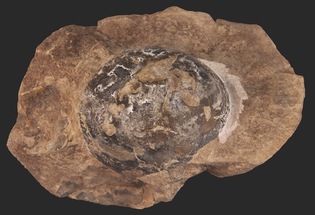 loading
loading
FindingsSoft serveUnlike birds, dinosaurs laid soft-shelled eggs, new research reveals.  A fossilized Mussaurus egg. View full imageThe idea that birds are our backyard dinosaurs is now well accepted. But in one important aspect of dinosaur behavior and evolution—egg-laying—birds led scientists astray. Birds lay hard-shelled eggs, and eggshell fragments are common in the fossil record. As a result, says Jasmina Wiemann, a doctoral student in molecular paleobiology, “we’ve long thought that the calcified egg shell was the ancestral condition.” Now, new research by Wiemann, doctoral student Matteo Fabbri, American Museum of Natural History (AMNH) curator Mark Norell ’88PhD, and an international team has made that notion extinct. “The first dinosaur egg was soft-shelled,” Wiemann writes in Nature. The discovery suggests that early dinosaurs, like turtles and lizards, laid soft-shelled eggs and buried them in underground nests. The hard-shelled egg evolved later. The researchers studied fossilized Protoceratops eggs (one is pictured), laid some 80 million years ago, that had been housed in the AMNH. “Mark Norell told us there was something weird about the eggs,” Wiemann says—“a dark halo that suggested they might be soft-shelled.” The team used new techniques developed by Wiemann and her colleagues. With polarized light microscopy and a nondestructive method of chemical analysis, they determined the eggshells’ molecular structure. When they compared it with modern shells, the fossil structure matched that of turtle and lizard eggs. And a study of 200 million-year-old Mussaurus dinosaur eggs revealed that they, too, were soft-shelled. “There’s a treasure trove of unstudied material in museum collections,” says Wiemann. “Using these new techniques could change the way we look at fossils and even help us understand how ancient animals went through times of major environmental change.”
The comment period has expired.
|
|